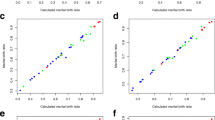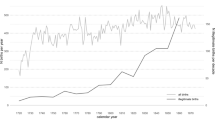Summary
Demographic analyses from 3 cohorts of Kenyan Kipsigis women married between 1940 and 1973 demonstrate that early maturing women have higher reproductive success than do late maturing women, due to longer reproductive lifespans and higher fertility. This result is independent of confounding effects of husband's wealth, but not of the wealth of a woman's parents which affects both menarcheal age and subsequent reproductive success. Data on bridewealth payments at 194 marriages occurring after 1959 show that men make higher marriage payments for early maturing women than for late maturing women. Together these results suggest that Kipsigis men vary their marriage payments in accordance with the reproductive value of their brides. The question of why men use age at menarche rather than bride's parents' wealth as a cue to their bride's subsequent reproductive performance is discussed in the light of changing social and economic conditions experienced by Kipsigis since the late 1920s.
Similar content being viewed by others
References
Aghajanian A (1981) Age at first birth and completed family size in western Malaysia. J Biosocial Sci 13:197–201
Apter D, Vikho R (1983) Early menarche, a risk factor for breast cancer. J Clin Endocrinol Metab 57:82–86
Bongaarts J (1980) Does malunutrition affect fecundity? A summary of the evidence. Science 208:565–569
Bongaarts J, Potter RG (1983) Fertility, biology and behavior: An analysis of the proximate determinants. Academic Press, New York
Bongaarts J, Frank O, Lesthaeghe R (1984) The proximate determinants of fertility in sub-Saharan Africa. Popul Demo Rev 10:511–537
Borgerhoff Mulder M (1985) Polygyny threshold: a Kipsigis case study. Nat Geo Res Rep 21:33–39
Borgerhoff Mulder M (1987a) Resources and reproductive success in women, with an example from the Kipsigis. J Zool 213:489–505
Borgerhoff Mulder M (1987b) On cultural and reproductive success: Kipsigis evidence. Am Anthropol 89:617–634
Borgerhoff Mulder M (1987c) Marriage and reproduction in the Kipsigis of Kenya. Phd dissertation, Northwestern University
Borgerhoff Mulder M (1987d) Adaptation in evolutionary biological anthropology. Man 22:24–41
Borgerhoff Mulder M (1988a) Kipsigis bridewealth payments. In: Betzig L, Borgerhoff Mulder M, Turke P (eds) Human reproductive behaviour. Cambridge University Press, Cambridge, pp 65–82
Borgerhoff Mulder M (1988b) Reproductive success in three Kipsigis cohorts. In: Clutton-Brock TH (ed) Reproductive success. Chicago University Press, Chicago, pp 419–435
Borgerhoff Mulder M (1989a) Reproductive consequences of sex-biased inheritance for the Kipsigis. In: Standen V, Foley RA (eds) Comparative socioecology, Blackwell, Oxford (in press)
Borgerhoff Mulder M (1989b) Menarche, menopause and reproduction in the Kipsigis of Kenya. J Biosocial Sci (in press)
Bumpass L, Rindfuss R, Janosik R (1978) Age and marital status at first birth and the pace of subsequent fertility. Demography 15:75–86
Burrell RJW, Healey MJR, Tanner JM (1961) Age at menarche in South African Bantu school girls living in the Transkei Reserve. Hum Biol 33:250–261
Caro TM, Borgerhoff Mulder M (1987) The problem of adaptation in the study of human behavior. Ethol Sociobiol 8:61–72
Clutton-Brock TH, Albon SD (1979) The roaring of red deer and the evolution of honest advertisement. Behaviour 69:145–170
Comaroff JL (ed) (1980) The meaning of marriage payments. Academic Press, New York
Critescu M (1975) Differential fertility depending on the age of puberty. J Hum Evol 4:521–524
Cutler WB, Garcia CR, Krieger AM (1979) Infertility and age at first coitus: a possible relationship. J Biosocial Sci 11:426–432
Davies NB, Halliday TR (1978) Deep croaks and fighting assessment in toads Bufo bufo. Nature 274:683–685
Delgado H, Lechtig A, Martorell F, Brineman E (1978) Nutrition, lactation and postpartum amenorrhea. Am J Clin Nutr 31:322–327
Ellison PT (1981) Prediction of age at menarche for annual height increments. Am J Phys Anthropol 56:71–75
Epstein E, Guttman R (1984) Mate selection in man: Evidence, theory and outcome. Soc Biol 31:243–278
Fisher RA (1958) The genetical theory of natural selection. Oxford University Press, Oxford
Frisch RE (1972) Weight at menarche: similarity for wellnourished and undernourished girls at differing ages, and evidence for historical constancy. Pediatrics 50:445–450
Frisch RE (1975) Critical weights, a critical body composition, menarche and the maintenance of menstrual cycles. In: Watts ES, Johnson FE, Lasker GW (eds) Biosocial interelations in population adaptation. Mouton, The Hague, pp 319–351
Frisch RE, McArthur JW (1974) Menstrual cycles: fatness as a determinant of minimum weight for height necessary for the maintenance and onset. Science 185:949–951
Garn SM, Haskell JA (1959) Fat and growth during childhood. Science 130:1711–1712
Garn SM, LaVelle M (1983) Reproductive histories of low weight girls and women. Am J Clin Nutr 37:862–866
Garn SM, LaVelle M, Pilkington JJ (1983) Fatness comparisons of premenarcheal and postmenarcheal girls at the same age. J Pediatr 103:328–331
Garn SM, LaVelle M, Rosenberg KR, Hawthorne VM (1986) Maturational timing as a factor in female fatness and obesity. Am J Clin Nutr 43:879–883
Gray RH (1976) The menopause-epidemiological and demographic considerations. In: Beard RJ (ed) The menopause: a guide to current research and practice. University Park Press, Baltimore, pp 26–40
Gray RH (1979) Biological and social interactions in the determination of late fertility. J Biosocial Sci (Suppl) 6:97–115
Gray RH (1983) The impact of health and nutrition on natural fertility. In: Bulatao RA, Lee RD (eds) Determinants of fertility in developing countries, vol 1. Supply and demand for children. Academic Press, New York, pp 139–162
Gubhaju B (1983) Fertility differentials in Nepal. J Biosocial Sci 15:325–331
Hakansson T (1985) Who do Gusii women get maried? A study of cultural constraints and women's strategies in a rural community in Kenya. Folk 27:89–114
Haugerud A (1983) The consequences of land tenure reform among smallholders in the Kenya Highlands. Rural Africana 15–16:65–89
Jelliffe DB, Jelliffe EFP (1978) Human milk in the modern world: Psychosocial, nutritional, and economic significance. Oxford University Press, Oxford
Jones B, Leeton J, McLeod I, Wood C (1973) Factors influencing the age of menarche in a lower socioeconomic group in Melbourne. Med J Aust 2:533–535
Lechtig A, Klein RE (1981) Pre-natal nutrition and birth weight: Is there a causal association? In: Dobbing J (ed) Maternal nutrition in pregnancy-eating for two? Academic Press, New York, pp 131–174
Lunn PG, Prentice AM, Austin S, Whitehead RG (1980) Influence of maternal diet on plasma-prolactin levels during lactation. Lancet I:623–625
Lunn PG, Austin S, Prentice AM (1984) The effects of improved nutrition on plasma prolactin concentrations and postpartum infertility in lactating Gambian women. Am J Clin Nutr 39:227–235
Mair L (1969) African marriage and social change. Frank Cass, London
Manners RA (1967) The Kipsigis of Kenya: culture change in a “model” East African Tribe. In: Steward J (ed) Contemporary change in traditional societies, Vol I. Introduction and African tribes. University of Illinois Press, Urbana, pp 207–359
Mascie-Taylor CGN (1988) Assortative mating for psychometric characters. In: Mascie-Taylor CGN, Boyce AJ (eds) Mating patterns. Cambridge University Press, Cambridge (in press)
Menken J, Trussel J, Watkins S (1981) The nutrition-fertility link: An evaluation of the evidence. J Interdiscip Hist 11:425–441
Mwanzi HA (1977) A history of the Kipsigis. East African Literature Bureau, Nairobi
Orchardson IQ (1961) The Kipsigis. Kenya Literature Bureau, Nairobi
Parkin D (1980) Kind bridewealth and hard cash. In: Comaroff JL (ed) The meaning of marriage payments. Academic Press, New York, pp 197–220
Peristiany JG (1939) The social institutions of the Kipsigis. Routledge and Kegan Paul, London
Pilgrim J (1961) Social and economic consequences of land enclosure in the Kipsigis Reserve. East African Institute of Social Research, Kampala
Prema KA, Nadamuni A, Neelakumari S, Ramalakshmi BA (1981) Nutrition-fertility interaction in lactating women of low income groups. Br J Nutr 45:461–467
Richerson PJ, Boyd R (1987) Simple models of complex phenomena: The case of cultural evolution. In: Dupré J (ed) The latest on the best. MIT Press, Cambridge, pp 27–52
Ryder NB (1969) Relationship among intended, expected, desired and ideal family size: United States, 1965. Center for Population Research, Princeton
Ryder NB (1976) Some sociological suggestions concerning the reduction of fertility in developing countries. Paper No. 37, East-West Population Institute, Honolulu
Ryder NB, Westoff CF (1971) Reproduction in the United States. Princeton University Press, Princeton
Saltman M (1977) The Kipsigis: A case study in changing customary law. Shehkman Publishing Company, Massachusetts
Sandler DP, Wilcox AJ, Horney LF (1984) Age at menarche and subsequent reproductive events. Am J Epidemiol 19:765–774
Scott EC, Johnston FE (1982) Critical fat, menarche, and the maintenance of menstrual cycles: A critical review. J Adolescent Health Care 2:249–260
Scott EC, Johnston FE (1985) Science, nutrition, fat, and policy: Tests of the critical-fat hypothesis. Curr Anthropol 26:463–473
Tanner JM (1981) A history of the study of human growth. Cambridge University Press, Cambridge
Thiessen D, Gregg B (1980) Human assortative mating and genetic equilibrium: An evolutionary perspective. Ethol Sociobiol 1:111–140
Toweett T (1979) The oral traditional history of the Kipsigis. Kenya Literature Bureau, Nairobi
Udry JR (1979) Age at menarche, at first intercourse, and at first pregnancy. J Biosocial Sci 11:433–441
Udry JR, Cliquet RL (1982) Cross-cultural examination of relationships between ages at menarche, marriage and first birth. Demography 19:53–63
Williams GC (1975) Sex and evolution. Princeton University Press, Princeton
Wray MD (1977) Maternal nutrition, breast feeding and infant survival. In: Mosley WH (ed) Nutrition and human reproduction. Plenum Press, New York, pp 197–230
Author information
Authors and Affiliations
Rights and permissions
About this article
Cite this article
Mulder, M.B. Early maturing Kipsigis women have higher reproductive success than late maturing women and cost more to marry. Behav Ecol Sociobiol 24, 145–153 (1989). https://doi.org/10.1007/BF00292097
Received:
Accepted:
Issue Date:
DOI: https://doi.org/10.1007/BF00292097




